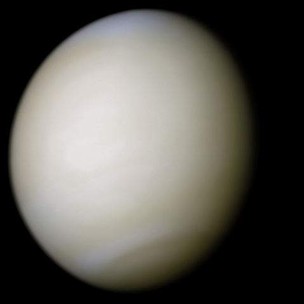Venus - the second in terms of distance from the Sun planet of the solar system . It is the third brightest celestial object in the sky after the Sun and the Moon. The observed magnitude reaches -4.6 m and is sufficient to light reflected from Venus resulted in the formation of shadows. In view of the fact that Venus is closer to the Sun than the Earth , it is always visible a short distance from him , her maximum elongation is 47.8 ° . The distance of Venus from Earth varies from 40 to 259 million km [1].
Planet name comes from the Roman goddess of love , Venus. Due to the fact that the night sky is visible only for about three hours before sunrise [2 ] or after sunset [2 ] is also called the Morning Star ( the dawn ), or the Star of the Evening .
Venus is classified as rocky planet (also known terrestrial ) and is sometimes called the " twin planet " or " Earth's sister planet " - because of the similar size , mass and chemical composition [ 3]. It is covered with an opaque layer of well- reflective clouds of sulfuric acid , which does not allow the observation of the surface from space in visible light . It has the densest atmosphere of all the terrestrial planets in the Solar System , consisting mostly of carbon dioxide. Venus has no carbon cycle that would result in the binding of carbon in the rocks. There was also its no traces of living organisms , which would bind it in biomass . It is believed that in the past were oceans on Venus as on Earth [4 ], but it evaporated when the surface temperature increased. The current landscape of Venus is dry and desert , created by the dust-covered rocks . The water in the atmosphere is likely dysocjowała , and because of the lack of the magnetic field , the hydrogen has been blown away in interplanetary space by the solar wind . [5] Atmospheric pressure at the surface of the planet is about 92 times greater than on Earth.

